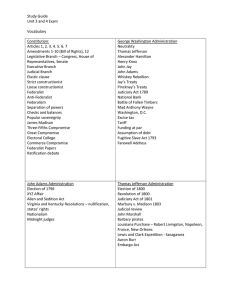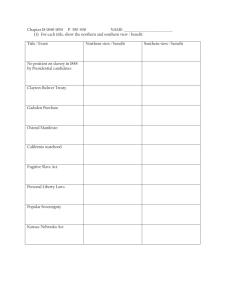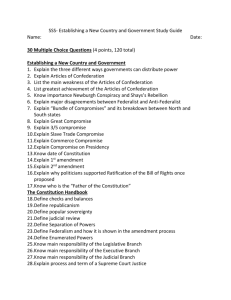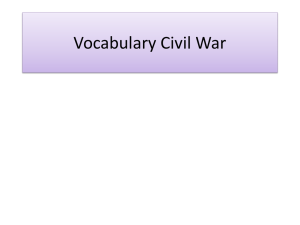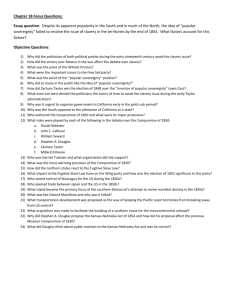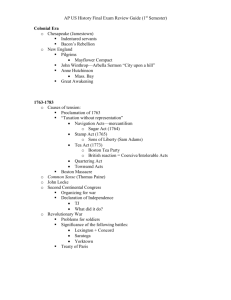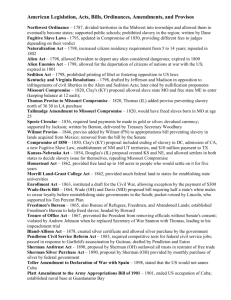Study Guide KC 1301
advertisement
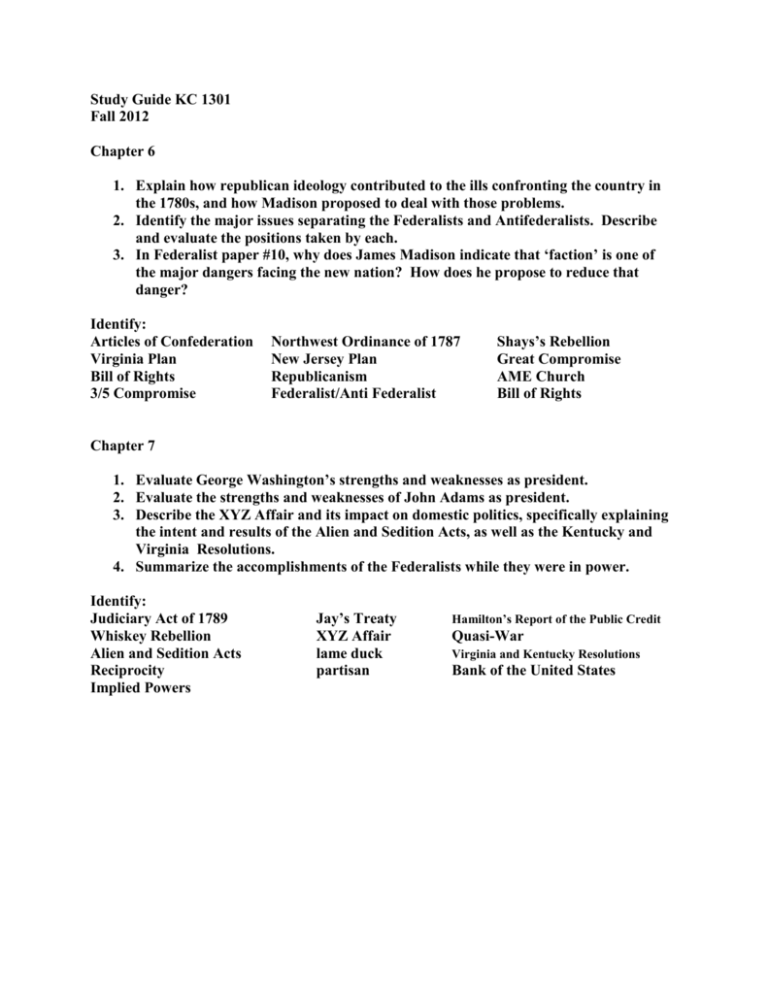
Study Guide KC 1301 Fall 2012 Chapter 6 1. Explain how republican ideology contributed to the ills confronting the country in the 1780s, and how Madison proposed to deal with those problems. 2. Identify the major issues separating the Federalists and Antifederalists. Describe and evaluate the positions taken by each. 3. In Federalist paper #10, why does James Madison indicate that ‘faction’ is one of the major dangers facing the new nation? How does he propose to reduce that danger? Identify: Articles of Confederation Virginia Plan Bill of Rights 3/5 Compromise Northwest Ordinance of 1787 New Jersey Plan Republicanism Federalist/Anti Federalist Shays’s Rebellion Great Compromise AME Church Bill of Rights Chapter 7 1. Evaluate George Washington’s strengths and weaknesses as president. 2. Evaluate the strengths and weaknesses of John Adams as president. 3. Describe the XYZ Affair and its impact on domestic politics, specifically explaining the intent and results of the Alien and Sedition Acts, as well as the Kentucky and Virginia Resolutions. 4. Summarize the accomplishments of the Federalists while they were in power. Identify: Judiciary Act of 1789 Whiskey Rebellion Alien and Sedition Acts Reciprocity Implied Powers Jay’s Treaty XYZ Affair lame duck partisan Hamilton’s Report of the Public Credit Quasi-War Virginia and Kentucky Resolutions Bank of the United States Chapter 8 1. Describe the condition and advances of the American economy in this era. 2. List the goals of Jefferson as president and evaluate his success in accomplishing them. 3. Explain the circumstances and consequences of the Louisiana Purchase. 4. Describe the background, results, and significance of the Marbury v. Madison decision (1803). 5. Discuss the reasons for the ultimate demise of the Federalist party during this era. Identify: Tecumseh ‘War Hawks’ stalwarts Louisiana Purchase Battle of New Orleans Albert Gallatin Treaty of Ghent precedent Marbury v. Madison Hartford Convention Lewis & Clark Expedition embargo act impressment Judicial Review Chapter 9 1. Describe the process by which western lands were organized and sold 2. List and explain the reasons why the South became the world’s greatest cotton producer. 3. Develop the main issues of sectional disturbance that accompanied the Missouri Compromise 4. Explain the perceived international conditions that led to the Monroe Doctrine as well as the specific intent of this statement. Identify: Adams-Onis Treaty John Ross Missouri Compromise “Era of Good Feeling’ Squatter nationalism Dartmouth College v. Woodward Gibbons v. Ogden ‘Preemption’ Rights McCulloch v. Maryland market economy Monroe Doctrine Chapter 10 1. Explain factors that contributed to the rise of democracy in the 1820s and 1830s. 2. Evaluate the main political and economic issues brought forth in the 1824 and 1828 elections and explain the outcomes of those presidential elections. 3. Summarize the problems encountered under Jackson’s Indian-removal policy. 4. Evaluate Jackson’s strategy in ‘killing the Bank’ and his use of state banks as depositories. 5. Understand the reasons for political realignment in the 1830s and the emergence of the Whigs. 6. Paraphrase both the blessings and perils of American democracy according to Tocqueville. Identify: “Spoils System Nullification Crisis Social leveling Peggy Eaton The Bank War laissez-faire “kitchen cabinet” “Trail of Tears” Popular Sovereignty plurality Panic of 1837 Chapter 11 1. Offer an overview of the complicated and diverse institution of slavery. 2. Describe the life of free blacks in the Old South. 3. Explain the arguments and issues surrounding the profitability and efficiency of slavery. 4. List the arguments for and against slavery offered by southerners. Identify: Nat Turner Abolitionism Underground Railroad staple Chapter 12 Identify: Charles G. Finney Horace Mann Harriet Tubman Theodore D. Weld Second Great Awakening the Liberator Seneca Falls Convention Sarah Grimke’ Yeoman Farmer deportation internal slave trade Jacobins Cult of True Womanhood Frederick Douglass William Lloyd Garrison Lyman Beecher 1. List the factors that caused the Second Great Awakening and discuss the differences between the revivalism that swept the South and the North. 2. Explain the purpose of public education according to Horace Mann. 3. Evaluate the results of the Seneca Falls Convention of 1848 4. Assess Hawthorne’s interpretation of reform. Is it valid? Explain Chapter 13 “Young America” John Tyler Zachary Taylor Winfield Scott Cyrus McCormick Stephen F. Austin James K. Polk Treaty of Guadalupe Hidalgo Samuel F.B. Morse John Deere “Remember the Alamo” Manifest Destiny John C. Fre’mont Charles Goodyear 1. Explain the causes, events and results of the Texas Revolution. 2. Discuss the political problems encountered over the annexation of Texas by the United States 3. ID the candidates and issues and explain the outcome and consequences of the election of 1844 4. Discuss the rationale for expansion as expressed in the doctrine of Manifest Destiny 5. Describe the changing composition and attitudes of the American working class during this era. Chapter 14. Popular Sovereignty Kansas-Nebraska Act James Buchanan Martin Van Buren “Freeport Doctrine” Ostend Manifesto Fugitive Slave Law Know-Nothings Dred Scott v. Sanford Uncle Tom’s Cabin Wilmot Proviso Franklin Pierce John Brown Abraham Lincoln Compromise of 1850 gerrymandered 1. Define and analyze the following proposals made to solve the problem of extending slavery to new territories after the Mexican War: (a) Wilmot Proviso, (b) extension of the Missouri Compromise line, and (c) squatter or popular sovereignty. 2. Explain the motivations for and the consequences of the Kansas-Nebraska Act of 1854. 3. Discuss the effects of social and cultural sectionalism in preparing the path for southern secession. 4. Discuss the background, final decision, criticisms and implications of the Dred Scott case of 1857. Chapter 15 Writ of habeas corpus Crittenden compromise Robert E. Lee Emancipation Proclamation resolution Fort Sumter Ulysses S. Grant emancipation conscription “Total War” Antietam Sanitary Commission 1. Explain why Lincoln was so effective as the Union’s wartime leader and compare him to Jefferson Davis. 2. Evaluate the Republican decision to reject the Crittenden compromise plan 3. List and describe the principal social and economic changes that accompanied the Civil War. 4. Describe the lasting effects of the Civil War on the nation. Chapter 16 Disfranchisement Specie 14th Amendment Compromise of 1877 13th Amendment Tenure of Office Act Compromise of 1877 impeachment Jim Crow laissez faire rider 10% plan Freedmen’s Bureau Radical Republicans Black Codes Carpetbaggers KKK “New South” Wade-Davis Bill 15th Amendment Scalawags Black Codes Force Acts Civil Rights Bill of 1866 Sharecropper 1. Describe the processes by which Andrew Johnson lost support in Congress and the Radical Republicans gained control of Reconstruction 2. Define the sections of the 14th amendment and understand why its enforcement was crucial to Reconstruction efforts. 3. Analyze the failings of the 15th Amendment. Consider how it might have been improved. 4. Discuss the Black Codes. How were they like slavery? How were they unlike slavery? 5. Discuss the enactment of Jim Crow laws and their impact on the South.
